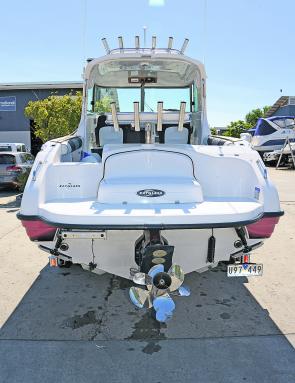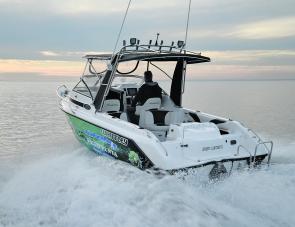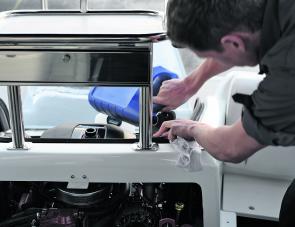With the rise in efficiency and reliability of modern outboards, you’d be forgiven for thinking that there was only one option for powering your trailerboat. But the outboard isn’t the solution for every single fishing or boating situation. Petrol and diesel sterndrive motors are available in plenty of configurations and horsepower combinations in the smaller (<300hp) sizes.
And it’s not just about having a rear cockpit free of an outboard protruding several feet from the boat to work around – although anglers that enjoy setting a spread of baits for everything from snapper to whiting will appreciate the options that an outboard-free boat offers.
Whittley’s Angelo San Giorgio doesn’t beat around the bush when it comes to separating sterndrive fact from fiction.
“You’d be forgiven for thinking that marine diesels are heavy, noisy, unrefined lumps of iron that chug along at low revs belching smoke, and vibrating more than a coin-operated washing machine down at the two dollar laundromat – hardly suitable attributes for compact trailerable craft,” Angelo said. “You’d be wrong.
“Recently Volvo Penta released the second generation of its compact D3 diesel platform aimed squarely at the trailerboating fraternity. These lightweight, diesel sterndrives with Electronic Vessel Control (EVC) thumb their collective noses at conventional wisdom and are now offered across the entire Whittley Marine Group’s fishing-oriented Sea Legend (SL) and Cruiser (CR) ranges.”
When it comes to diesel sterndrives, Mercury’s Tony Smith agrees.
“Mercury’s TDI sterndrives will use half the fuel of a comparable petrol powered V8 model, but that efficiency comes at a price – the TDI’s are more expensive to fit than both petrol inboard or outboard options,” he said at a recent boat test of their Rayglass TDI project boat.
That boat was fitted with the TDI 260HP and Tony continued about the advantages of the low centre-of gravity and different positioning of the engine.
“In rough water the ride is definitely different in a sterndrive powered craft,” he explained. “A big 400kg Verado on the transom when coming off a wave behaves very differently from an inboard, which, being centrally located, is much more stable.
Angelo said that Whittley sterndrives are buried low in the hull and forward of the transom to address this potential problem.
“We position the sterndrives so their weight never contributes to the ‘pendulum’ effect often exhibited by the installation of heavy outboards on deep vee hulls,” Angelo said.
“All our sterndrive installations can be upgraded to Volvo's Duoprop drive which features an enhanced gearbox running a pair of counter-rotating props on the one shaft. The net result is instant holeshot with minimal bow lift and better tracking at low speeds, all while burning less fuel than its outboard equivalent.”
In the coming months, you’ll read about a couple of Whittley Volvo-inboard powered boats that Wayne Kampe got to Melbourne to test. Whittley’s Angelo continues about whether petrol or diesel sterndrives are the best.
“Either option works well and the choice would be dictated by budget and intended application,” he said. “The diesel alternative comes at a premium, but still represents remarkable value, particular considering they are freshwater cooled, and burn fuel at up to half the rate of petrol options. In the case of Volvo Penta's D-3 series, they are also lighter than the petrol equivalents while packing prodigious torque at all revs.”
Both of our sterndrive experts agree that although the maintenance intervals are around the same, the service costs of a sterndrive are higher than an outboard.
“Sterndrives traditionally are a bit more expensive to service than outboards. Allow for an extra couple of hundred dollars per year, but bear in mind that you would've saved more than that on your annual fuel bill not to mention that low initial purchase price if you purchased a boat with Volvo Penta's V-6 200,” Angleo says.
“Every year or 100 hours - the same as our outboards,” says Mercury’s Tony.
Both advocates of the inboard-option stated some compelling reasons to at least consider the possibility of buying a fishing trailerboat with an inboard motor, but we let Angelo have the last word.
“Since Volvo Penta's V6-200 sterndrive is now the standard engine for every model in Whittley's Cruiser (CR) and Sea Legend (SL) fleets, we can package this four-stroke 4.3L petrol engine for the equivalent price of a 70-80hp four-stroke outboard or less than half the price of a 200hp outboard,” he said. “That's right... improved performance and handling for half the money!”
Check ‘em out.
Reads: 5324
Sterndrives allow trimming the boat with a tilt-able leg.

Transoms on sterndrive boats are remarkably clear of obstructions.

Clever sterndrive installations can enhance a boat’s rear end.

Convenient engine access is a Whittley trait.

The compact Volvo Penta D3 diesels might be light in weight but are no lightweight when it comes to performance.




